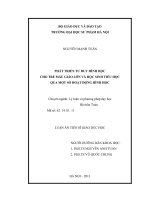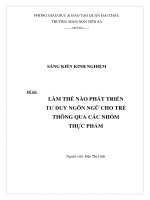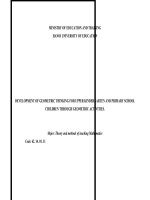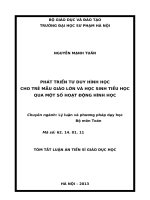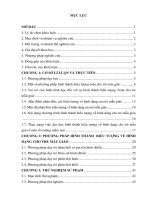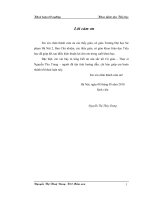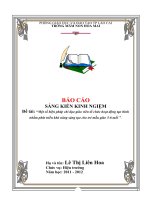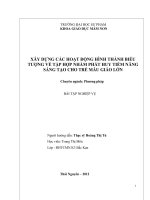phát triển tư duy hình học cho trẻ mẫu giáo lớn và học sinh tiểu học qua một số hoạt động hình học bản tóm tắt tiếng anh
Bạn đang xem bản rút gọn của tài liệu. Xem và tải ngay bản đầy đủ của tài liệu tại đây (397.66 KB, 34 trang )
MINISTRY OF EDUCATION AND TRAINING
HANOI UNIVERSITY OF EDUCATION
DEVELOPMENT OF GEOMETRIC THINKING FOR UPPER KINDERGARTEN AND PRIMARY SCHOOL
CHILDREN THROUGH GEOMETRIC ACTIVITIES.
Major: Theory and methods of teaching Mathematics
Code: 62. 14. 01. 11
SUMMARY OF PEDAGOGICS DOCTORAL THESIS
HA NOI – 2013
Science instructor:
1.ASS.Prof, Dr. Nguyen Anh Tuan
2.ASS.Prof, Dr. Vu Quoc Chung
Judge 1: ASS.Prof, Dr. Tran Kieu
Judge 2: ASS.Prof, Dr. Vu Duong Thuy
Judge 3: Dr. Nguyen Van Thuan
Thesis will be defended in front of Council at University
Hanoi University of Education, date:…………………….
Thesis can be seen at National Library and Library of Hanoi National University of Education.
LIST OF THE AUTHOR’S RESẺACH PROJECT RELATED TO THESIS
A.Articles have been published
1. Nguyen Manh Tuan (2009), Van hiele’s viewpoint on forming geometric symbols in kindergatern children and pupils of early
primary school, Journal of Education No. 224, pp.35-38.
2. Nguyen Manh Tuan (2010), Spatial imagination and development of spatial imagination for students in early years of primary
level with educational software. Journal of Education No. 248, pp.5-7.
3. Nguyen Manh Tuan (2011), Developing Spatial Imagination in Children Aged 5-6 years by Formatting Shape
Representations. Proceedings 13, Global COE Program "Science of Human Development for Restructuring the Gap - Widening
Society", Ochanomizu University, pp.153-156.
4. Nguyen Manh Tuan (2011), Training geometric thinking for children aged 5-6 and early primary (grade 1, 2, 3) through
teaching the relative position of things, Journal of Science National University of Education, No. 6, pp.96-103.
5. Nguyen Manh Tuan (2011), Studying the impact of spatial sense and spatial imagination in upper kindergatern children,
Journal of Education No. 266, pp.9-11.
6. Nguyen Anh Tuan - Nguyen Manh Tuan (2011), Drilling geometry thinking for kindergatern and primary school children
(Grade 1, 2, 3), Journal of Science Education, Institute of Education Sciences, Vietnam, No. 72, pp.35-40.
7. Nguyen Manh Tuan (2012), Orientation for forming methodological knowledge for upper kindergatern children and lower
primary students through several geometric activities. Journal of Education No. 289, pp.36-39.
B.Scientific Research subjects
1. Nguyen Manh Tuan (2011), The process and a number of methods to form geometric symbols from upper kindergarten to the
early primary school children (grades 1, 2, 3), the topic of school.
INTRODUCTION
1. The reasons for this topic
The development of thinking, creative ability and practical skills education is a requirement in our education today.
Education development strategy for 2011-2020 (Decision No. 711/QD-TTg) stated: " Fundamental and comprehensive
innovation of education in the direction of standardization, modernization, socialization, democratize, international
integration, focus on improving the quality, especially the quality of moral education, lifestyle, thinking, creative ability,
practical skills to not only meet the requirements of socio-economic development but also focus on satisfying the needs of
development for each learner, the person who has aptitude can develop their talent "
Innovation project of textbook content emphasized on development of capacity and thinking for children, in which they
have plenty of opportunity to solve the problem and show how to solve the problem with other people; require them to apply the
knowledge to solve the situations which set out in practical life for individuals and communities. Doing that also means
contributing to "load reduction" for learners.
Developing for children's thinking through the teacher established and organized activities that is regarded as the guiding
ideology throughout the innovation of teaching methods. According to A.N.Leonchev, the discovery of the common structure
between the two types of inside activity and outside activity is one of the most important discovery of modern psychological
science: " Inside activity and outside activity have the same structure, Inside activity comes from outside activity, is formed from
outside activity.Thinking as inside activity is formed through the human’s process of working .
Geometry teaching is a favorable condition for development of thinking for learners - especially the quality of flexible ,
independence and creativity thinking , develops spatial imagination and intellectual activities such as comparison, analysis,
synthesis, generalization, At the primary level, the formation of geometric elements and geometric quantities also helps
1
children with fundamental knowledge of mathematics, helps children be aware of the world around them and learn mathematics
in the future in higher levels. In which, the method of using the geometric activities plays an important role in teaching geometric
elements and geometric quantities and develops thinking for learners. Through geometric activities, the children can learn in the
activities and by the activities, can self-doing, self-deciding, can experience practical life leading to contribute to promote
positiveness, independence, creativeness, increase interest in the Math class that keep children innocent and happy in early school
age .
However, organizing geometric activities at school has some limitations. Although the content of kindergarten and primary
education program now focus on more geometric activities, but teachers do not really evaluate the level of thinking and
awareness of children in geometric activities. The geometric activities also occur scatteredly and disorderly during the process of
geometric elements and geometric quantities teaching, the teachers have not really applied effectively in the Review class or
extracurricular activities, especially the 2 sessions - class / one day in elementary school, the teachers usually recommend or
deduct from reference books, primary school children mainly take time to do homework in class, the teachers focus on teaching
knowledge more than training and developing thinking for children, organize less activities for children. The reason is that
teachers do not pay proper attention to the role of geometric activities for the development of thinking, the establishment and
organization of geometric activities which required time-consuming, the teachers are difficult and confused in evaluating
children, do not control children.
Before the children enter elementary school, children have certain awareness and understanding through activities which
help chidren be familiar with Math in kindergarten, five-year-old universal project of the Ministry of Education and Training has
been implemented with the goal of completing the whole country in 2015 and also raised new questions about the "connection"
the content of program of making familiar with Math for children at upper kindergarten and curriculum in mathematics for
2
elementary children school. So researching on teaching Math in general, geometric elements and geometric quantities teaching in
particular from children at kindergarten (5 years) to children at primary school is necessary, the teacher must not teach before the
program , "primarized education" children at kindergarten, at the same time avoid children’s psychology to be"boring" when
entering the first grade.
For these reasons, the chosen topic is: " Development of geometric thinking for upper kindergatern and primary school children through
geometric activities”
2. The research purposes
Development of geometric thinking for upper kindergarten children and at primary school children through the selection,
construction, orgnization some geometric activities.
3. The objects of research
The process of formation of the geometric elements and geometric quantities for upper kindergarten children and at
primary school children
4. Scientific hypothesis
Because the activity plays an important role in the development of children's thinking, so if we can evaluate the children’s
level of geometric thinking and design, organize suitable geometric activities in teaching of geometric elements and geometric
quantities, children’s geometric thinking will be better developed, teaching of geometric elements and geometric quantities will
achieve higher efficiency.
5. The research tasks
Research the basic of theory.
3
The topic studied about basic theoretical of geometric thinking and characteristics of development geometrica thinking in
upper kindergarten children and at primary school children;concepts related geometric thinking; levels of geometric thinking.
Investigate the level of geometric thinking capacity in upper kindergarten children and at primary school children
5.3.Estabish some methods to develop geometric thinking capacity of upper kindergarten children and at primary school children
- Assess the level of geometric thinking capacity through some geometric activities.
- Develop and organize some geometric activities to establish the way to solve the problem;
- Increase applying mathematics in practice;
- Apply situation theory and make situations to develop geometric thinking for children.
Pedagogical experiment: Pedagogical experiments test the validity of scientific theories and the feasibility of the
methods which are proposed and studied by the topic.
6. The scope of the research
Study of the development of geometric thinking for upper kindergarten children and at primary school children through
some geometrical activities in schools.
7. Research Methodology
- Academic research methods: study the psychological characteristics of upper kindergarten children and at primary
school children; study the development of thinking in general and geometric thinking in particular in the process of
teaching of geometric elements and geometric quantities for children in the country and over the world;
- Method of summarizing educational experiences;
- Methods of observation: Observe and record the activities of teachers and children in kindergarten and primary school to
learn manual operation, organize for kids in the class making acquainted with geometric symbols;
4
- Methods of statistic: Using statistical methods to handle statistics to measure the level of geometric thinking
capacity in children to confirm the validity of scientific theories and the feasibility of the method which is raised in the
topic.
8. Issues defended in thesis
- The concept of geometric thinking in upper kindergarten children and at primary school children, the performance of
geometric thinking capacity in children through some geometric activities.
- Assess the geometric thinking capacity in upper kindergarten children and at primary school children in some geometric
activities.
- Develop geometric thinking through the estalishment and organization some geometric activities in upper kindergarten
children and at primary school children
9. The structure of the thesis
Besides the Introduction, Conclusion, References and Appendix, the thesis consists of three chapters:
Chapter 1: Fundamentals of theory and practice
Chapter 2: A number of methods to develop geometric thinking in upper kindergarten children and at primary school children
Chapter 3: Pedagogical experiment
5
CHAPER 1 : FUNDAMENTAL OF THEORY AND PRACTICE
1.1. History of research.
1.1.1 The research in Viet Nam
In general, these researches focus on methods of establishing and organizing thinking activities to develop thinking
through geometric elements and geometric quantities teaching in upper kindergarten children and at primary school children,
however the geometric activities is built mainly based on the teaching content in each class,the research of geometric activity
throughout the classes from kindergarten and at primary school has not really been interested and focused.
1.1.2 The research in the world
Dutch mathematics educators Van Hiele gave level of geometric thinking from low to high, from that he made the
evaluation tests for children and teaching methods which is applicable to each level are widely used in design of teaching
program content (in kindergarten children, primary school children and high school) in many countries in the world
Geometric thinking requires a combination of spatial concepts and symbols, between logical thinking and spatial
perception. Clements said that even when the children know a triangle has three sides and three angles, they called the "▲" is a
triangle but they can not accept the "▼" is a triangle because it "spin down under "- in other words, the visual icon element can"
obscure " thinking logic element and language. Here the teacher plays an important role in establishing between the space the
symbol and cognitive concept.
According to Hoffer (1981), the geometric thinking is the capacity which teachers need to form in children in the teaching
of geometry, he gave five groups of necessary skills of geometry thinking
i) The capacity of visual - images: Identify, observe the characteristics of geometry, reading a map, identify the different
positions;
6
ii) The capacity of language: Use correct terminology and accuracy language in describing the object and spatial
relationships;
iii) The capacity of making shape: Create icons of two-dimensional or three-dimensional, drawing similar figures, drawing
symmetric figures;
iv) The capacity of logical thinking: Classification, recognition criteria to classify, create and test hypotheses and
inference; demonstration;
v) The capacity of applying: Apply knowledge learned in practice, solving practical problems by geometry.
The research in the country and over the world have shown the existence of geometric thinking, the factors that affect the
capacity of the geometric thinking, the level of geometric thinking in children, have studied the role of the geometric activity for
the formation and development of geometric thinking. However, the evaluation of the geometric thinking in geometric activity
has not been interested. In the same content of teaching or the same geometric activity ,the children show different ways to solve
problem, how to think, how to solve the problem, the different difficulties and "obstacles", therefore it is necessary to have initial
research of evaluation geometric thinking capacity in geometric activities. On the other hand, the construction and organization of
geometric activities to promote geometric thinking and the differentiate between children has not really been focused, yet not
been diverse, not been rich, not shown the way of development from this level to the next higher level.
1.2. Geometric thinking
1.2.1. The concept of geometric thinking
Our concept: "Geometric thinking is the process including: 1) the perception of space; 2) the implementation of
intellectual activities such as comparison, analysis, synthesis, generalization, abstractionsymbolized, inference, provement; 3)
show how to solve the problem and 4) apply in practice. "
7
In which: Doing intellectual activities by children is the most important and it can be decided that children have geometric
thinking or not.
From conception above, The characterics of geometric thinking can be described :
1) The intellectual activities of geometric thinking is based on the perception of space
In work of thinking by eyes ,Arnheim argues that "the most important intellectual activities derived
directly from our perception of the world, and the view is considered premium sensory system which
covered and formed our cognitive processes. "Spatial perception itself is not thinking but is necessary to
carry out the geometric thinking, it will be difficult to solve geometric Mathematics without drawing
observation or at least thinking about drawing. Spacial perception is included in the perception of spatial
objects and spatial relations and movement combination between the senses (mostly the combination
between hand and eye ). In teaching the first age at school , the early basis visual is more significant because the child's thinking
is mainly visual thinking.
2) Geometric thinking has a close relationship with space imagination
- Geometric thinking is the condittion for children to carry out space imagination
For example : “How many cubes are there in the picture ?” This exercise requires children to use space imagination in
solving problems.However, that imagination is only formed in the process of observation, puzzle, analyze, compare cubes in
practice.
For example: The exercise for grade 1 in China: "Can you guess that how many door are
there in the picture, how many flowerpots are there in the picture (look for the most reasonable
answer)?"(Picture 1.7)
8
Picture 1.7
Picture 1.6
This problem requires the children to have space imagination.To do this, the children must have training activities of
observation and analysis - synthesis objects in space there is the analysis of what they "see" and what they "know but do not see
"(geometric thinking activities).
With a problem that can not be solved by geometric thinking, spatial imagination can help predict results, as “solving”
method for the situation.Moreover it creates a destination for thingking towards, or in other words, it orients for geometric
thinking.Thus the difficulties of geometric thinking is a premise for spatial imagination, and spatial imagination becomes the
destination for geometric thinking to develop.
3) Language is a part of geometric thinking.
4) The children can apply in practice which is a base to access geometric thinking
The ability to apply in practice is an important criteria for determining children’s geometric thingking capicity , they began
to approach with specific objects and relations, practice intellectual activities and return the application with the specific objects
around them.Through the teaching of geometric elements and geometric quantities, not only to teach children about things of
objects or spatial relations, but also to require what the children will do in practice.
On the base of the study of the characteristics of thinking upper kindergarten and elementary children (Section 1.2.4), the
study of level of geometric thinking according to Van Hiele (Section 1.2.3), can be understood: "Geometric thinking at this age is
the process including: 1) the perception of space; 2) Carry out intellectual activities such as comparison, analysis, synthesis, 3)
show the way to solve the problem, and 4) apply in practice. "
1.2.2. The role of geometric thinking
1.2.3. The level of geometric thinking according to Van Hiele
9
1.2.4. The characteristics of geometric thinking in upper kindergarten and elementary children
1.2.5. The capacity of geometric thinking in children
1.3.Develop the capacity of geometric thinking for children through geometric activities.
1.3.1. Geometric activity.
Geometric activitiy is the activity which is based on geometric models.With a view of enhancing the practice in teaching ,
establistment of geometric activities is necessary.
With a view of geometric activity is centered, is the basis of geometric thinking for children, the geometric activities take
place very early in children from the drawing activities, puzzles, coloring,squeeze in kindergarten and continue to develop in
elementary school, we found that the study of "vertical" continuously development, the connection between the level of education
is necessary.Thus the teachers found the way to develop geometric thinking and geometric activity in children and appropriate
teaching methods. Creating the way to solve problems during geometry activities, setting knowledge-tectonic situations, innovate
the assessment to contribute to reduce programs in textbooks
1.3.2.Performance of geometric thinking capacity of big kindergarten and elementary children during geometric activities
In the process of geometric activities for children, there can be proposal of evaluation of geometric thinking through the
following performance:
1) The capacity to perform intellectual activities (comparison, analysis, synthesis) is reflected on:
- Means which children used in activity: Which means and materials do children choose? How to use them ?
- Which difficuities, "obstacles" do children have in the process working?
- The result of activity : How is the level of completeness of activities?
2) The capacity of the language:
10
- How do the children use the term and common language in describing objects and spatial relationships?
- How do the children espress the way to solve problems with other people ?
3) Capacity of applying: What can the children do in practice? Can them answer and explain the specific objects and spatial
relationships in the environment around them?
In addition, each activity has its own characteristics that can be considered more performances of intellectual activities
such as : the activity to classify shapes, which criteria can the children use to classify? Do children use one or many criterias for
classification?
1.4.The content of geometric elements and geometric quantities teaching in big kindergarten and elementarychildren
1.4.1 In Vietnam
1.4.2.Compare the content of geometric elements and geometric quantities teaching in big kindergarten and elementarychildren in
Vietnam and some developed countries
1.5.Investigation under the direction of sorting the level of geometric thinking capacity in big kindergarten and
elementary school children in geometric activities.
1.5.1. Purposes of investigation
1.5.2. Methods of investigation
1.5.3. Objects and time of investigation
1.5.4. Contents and results of investigation
1.5.4.1. Assessment of capacity to implement the child's intellectual activities
1.5.4.2. Assessment of children of capacity to apply in practice
1.6. Conclusions of chapter 1
11
The research of basis theory shows an general overview of concept of geometric thinking and concepts related to geometry,
the characteristics of thinking of upper kindergarten and elementary children. The author has proposed the concept of geometric
thinking in children, depend on these bases to analyze the characteristics of geometric thinking, the performances of geometric
thinking capacity through some geometric activities.
The research of pratical base of the topic indicates that children who are in each class, and even in the same age, a class
with the guidance of teachers will have different perceptions, the different level of geometric thingking , in the process of
learning geometric elements and geometric quantities teachers can use the same question but the way to solve the problem of
children is different.Therefore the assessment of the process of geometric thinking is necessary, is the basis for teaching methods
which affects to children.
In the process of studying,the Author also found that the knowledge-equipped for children to solve a class of Mathematics
in geometric activities is neccessary and throughout the process of expanding and developing from simple to complex.At the
same time the research of incresing the capacity of applying mathematics in practice for children is also suitbale solution with
theory and practice.
CHAPTER 2: SOME METHODS OF THE DEVELOPMENT GEOMETRIC THINKING FOR UPPER
KINDERGARTEN AND ELEMENTARY CHILDREN.
2.1. Method 1: Assessing the capacity of geometric thinking of upper kindergarten and elementary children in geometric
activities.
2.1.1.Basis for the implementation of methods
2.1.2 Content of the methods
2.1.2.1. Assessing the capacity of geometric thinking of children in making shape activities.
12
2.1.2.2. Assessing the level of geometric thinking in classification of geometry or shape of objects.
2.1.2.3. Assessing the capacity of thinking in geometry activities geometric classification of the shape of an object
2.1.2.4. Assessing the level of geometric thinking in oriented activities in space
2.1.2.5. Assessing the level of geometric thinking in the measurement of geometrical quantities in practice
2.1.3. The meaning and suggested using methods.
The meaning of the assessment of geometric thinking capacity
The current level of geometric thinking capacity of the children will affect the way they act or react to solve the problem,
so it concerns what we can learn from these activities.Recognizing the level of geometric thinking helps teachers understand how
the children will react or act , understand better why they can do these activities but can not do other activities, as well as some
children have difficulty in this activity, the other children do not.The classification of geometric thinking through activities also
helps teachers recognize the "obstacles" that children have to overcome in the process of geometric activities and achieve the
goals of Geometry teaching.The performances given are suggestions to help the teacher to observe the children in the process of
orgnization geometric activities, and prove the level of children’s geometric thinking capacity also and suggest for teachers to
organize other geometric activities which is suitable with the level of geometric thinking.
Each level of children’s geometric thinking capacity is not understood as separated sets (Picture 2.1).That each level
contains the previous development and contains the necessary elements to achieve the next level of thinking (Picture
2.2).Children have not fully completed a level of geometric thinking capacity before they grow to the next level.This plays an
important role in designing geometric activities of teachers: While organizing activities to help children practice thinking levels
1 and 2, children should be prepared to the requirements at level 3 and higher level.
13
Picture 2.1 Picture 2.2
Current teaching programs designed as logic of content development.With the hierarchy above, each content of teaching of
geometric objects or geometric relationships in the program can be designed activities for children to go through the levels of
geometric thinking as the hierarchy. For example:
+ Unit 4, page 48, Mathematic 3: Give 8 equal triangles: Please put into the shape of a fish in the sample.Teacher organizes
geometric activities including 8 triangles as the sample; fish-shaped as the sample. Ask them to pave
Then we can graduated the level of geometric thinking capacity.
Level 1: Children "trial and error" in the whole process of paving
Level 2: Require children flat paving and tell the way to move of shape.
Level 3: Visualize before moving triangle: “How many triangles do you need to creat the fishtail? How many triangles do
you need to creat the body of fish?” “How do you creat fishtail?”
- The hierarchy of level of geometric thinking capacity does not mean that the children have to achieve every level in all
the activities ,depending on The content of Mathematics teaching which can be achieved sooner or later but the general situation
14
children can overcome the steps of thinking as above. For example: Introduction rectangular parallelepiped in the program of
Grade 5 when teacher requires children to draw one given rectangular parallelepiped , children can draw 1 rectangle
parallelepiped (level 1), then the child can draw two “ consecutive” rectangular parallelepipeds (level 2); or draw a
performance shape from their position; imagine to draw (perception) rectangular parallelepiped from different observation
positions (level 3).
Suggested implementing of methods
- Step 1: Prepare for geometric activities
- Step 2: Make observation paper , analyze and assess children (detailed in Appendix 3).
- Step 3: Carry out activities, observe and record the performance of children’s geometric thinking capacity (preferably
with the help of the media such as camera, photocamera),
- Step 4: Assess the level of geometric thinking capacity in children based on the results in Step 3, for comparison with
Table geometric thinking capacity in this activity; make the conclusion.
2.2.Method 2: Forming the way to solve the problem in some geometric activities, from that establishing and organizing
geometric activities.
2.2.1. Basis for the implementation of method
2.2.2. Content of method
The author built activities that oriented to form the way to solve problems, organize activities based on questions to creat
problems:
15
The way to solve the problem 1: When creating shape (drawing, folding, etc.), we need to think about the shape of the entire
object and the relationship of parts as well as the relationship of parts with whole objects.
The connotation of the way to solve the problem is creating shape to keep the original shape, that means they
"congruent" with the original object, the children need to:
- "Seeing" the constituent parts of whole objects
- Create each component part
- Connect them in the correct relationship to each other and in relationship to the entire object.
The way to solve problem 2: An expansion of shape must have the component shapes that are similar to cubes and components must be
placed in a certain way with each other.
Through practical work which focuses on the components of a cube and the way to "match" them each other, children need
to understand that the expansion of any shapes will need :
- Figures which have the appropriate shape and size.
- There are full of sides
- The correct position relatively each other.
The way to solve the problem 3: To demonstrate the performance shape of the cube ,we need to combine what we can actually
observe with something we imagine.
There are several ways to approach the performance of shapes on a plane, most adults can recognize that the shape looks
like a cube. For them, the cube has "turned out" and looks cubic. However, children may not realize that it is a cube, maybe they
16
"see" it is a "hexagonal", there are some lines which crossed together in the figure. When asked to draw again , they could draw a
picture included in three "diamonds". Therefore, children must learn to read the performance in the plane in its limitation to
“float” these figures.
Mathematics equipped with a number of rules to represent cube which are widely used and the children need to learn the
rules to explain and re-create them. Children must learn to know that:
- They can show what can be seen from a specific position and ignore something that we know they are there but can not
seen (we do not draw all four wheels if we can only see three wheels).
- They can "distort" the shape and size to make the drawings look more realistic, for example, drawing wheel as ellip and
display the further objects are, the smaller they are as the perspective drawings.
- They can draw differently from the reality to create a emphasized point on some characteristics, as the oblique and edge
drawings
The way to solve the problem 4: We can move the object around in space by moving and rotating the image. The action
does not change the size or shape.
Contents of the way to solve the problem:
- Looking at the entire figure which is need to be paved; constituent parts;
- Analysis the figure that can not be paved; the figure can be paved based on shape features;
- The children use the rotate action, movement action to lock into position to pave;
17
The way to solve the problem 5: The object can have the same characteristics and different characteristics, when classification,
we arrange the objects in the same group which they have the same characteristics .
Classification is the common activity in mathematics, such as classification of even and odd number in series of natural
numbers, or classification, arrangement the data is a common activity in content of Descriptive statistics.The content of the way
to solve this problem in the teaching of geometric elements and geometric quantities is when classifying we help children orient
the criterias for classification, children have to analyze, synthesize, compare the characteristics of the geometric objects.
Conclusion: The formation of the way to solve problems helps teachers with an general overview of the organization of
geometric activities, with a clear goal in the establíhment and organization of geometric activities, each geometric activity
not only improves and understands learnt symbols and concepts but also contributes to build the way of solving problem
for a class of Mathematics, a class of activities. We also need to understand that in order to formulate ways to solve the
problem, the children also has step-by-step implementation of the intellectual activities such as comparison and analysis -
synthesis, generalization. Thus the oriention of the main ways to solve the problem is to develop the intellectual activities,
contributing to the development of geometric thinking in children. The statement’s way to solve the problem in the form of
clause also helps teachers be easy to remember, to carry out and to make deeplier, more detail mathematical knowledge of
pre-school and primary school teachers.
2.3.Method 3: Increase using knowledge into practice in the process of geometric activities to help children answer,
explain the basis of many phenomena in the surrounding environment.
2.3.1. Basis for the implementation of method
2.3.2. Content of method
18
